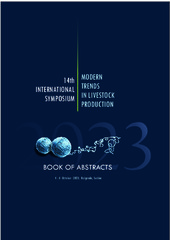Приказ основних података о документу
Fusarium and deoxynivalenol contamination of winter wheat depending on growing season and cultivar
| dc.creator | Krnjaja, Vesna | |
| dc.creator | Mandić, Violeta | |
| dc.creator | Stanković, Slavica | |
| dc.creator | Obradović, Ana | |
| dc.creator | Petrović, Tanja | |
| dc.creator | Vasić, Tanja | |
| dc.creator | Lazarević, Marina | |
| dc.date.accessioned | 2023-10-11T08:34:47Z | |
| dc.date.available | 2023-10-11T08:34:47Z | |
| dc.date.issued | 2023 | |
| dc.identifier.isbn | 978-86-82431-81-7 | |
| dc.identifier.uri | http://r.istocar.bg.ac.rs/handle/123456789/905 | |
| dc.description.abstract | Wheat is the most important staple food in the world and the main source of carbohydrates, fibre, proteins, vitamins, minerals and phytochemicals for human consumption. The nutrients from wheat kernels can also be used as livestock feed. Fusarium head blight (FHB), caused by fungal species of the Fusarium genus, is one of the most important wheat diseases worldwide. The lack of FHB management strategies results in significant economic losses in yield and quality of wheat kernels. In this study, the influence of growing season and wheat cultivar on some FHB and yield component traits, as well as on the trichothecene mycotoxin deoxynivalenol (DON) levels during the harvest period in 2014 and 2015, was investigated. Significant influence of growing season (year) and wheat cultivar on disease (FHB index – FHBI, incidence of Fusarium-damaged kernels – FDK and levels of DON) and yield parameters (spike weight – SW, kernel weight per spike – KWS, and 100-kernel weight) was found. FHBI, FDK, and DON were higher in 2014, while SW, KWS, and 100-kernel weight were lower in 2014 than in 2015. The mid-early wheat cultivar Simonida had lower FHBI, FDK, and levels of DON and significantly higher SW, KWS, and 100-kernel weight than the mid-late cultivar NS 40S. There was a significant effect of year × cultivar interaction on FHBI, FDK and 100-kernel weight. | sr |
| dc.language.iso | en | sr |
| dc.publisher | Institute for Animal Husbandry, Belgrade-Zemun, Serbia | sr |
| dc.relation | info:eu-repo/grantAgreement/MESTD/inst-2020/200022/RS// | sr |
| dc.relation | info:eu-repo/grantAgreement/MESTD/inst-2020/200040/RS// | sr |
| dc.relation | info:eu-repo/grantAgreement/MESTD/inst-2020/200116/RS// | sr |
| dc.relation | info:eu-repo/grantAgreement/MESTD/inst-2020/200383/RS// | sr |
| dc.rights | openAccess | sr |
| dc.rights.uri | https://creativecommons.org/licenses/by/4.0/ | |
| dc.source | Book of Abstracts of the 14th International Symposium „Modern Trends in Livestock Production“, 4 – 6 October 2023, Belgrade, Serbia. | sr |
| dc.subject | Fusarium head blight; | sr |
| dc.subject | Fusarium and deoxynivalenol contamination; | sr |
| dc.subject | yield component traits; | sr |
| dc.subject | winter wheat; | sr |
| dc.title | Fusarium and deoxynivalenol contamination of winter wheat depending on growing season and cultivar | sr |
| dc.type | conferenceObject | sr |
| dc.rights.license | BY | sr |
| dc.citation.spage | 80 | |
| dc.citation.epage | 80 | |
| dc.identifier.rcub | https://hdl.handle.net/21.15107/rcub_ristocar_905 | |
| dc.identifier.fulltext | http://r.istocar.bg.ac.rs/bitstream/id/4293/bitstream_4293.pdf | |
| dc.type.version | publishedVersion | sr |


